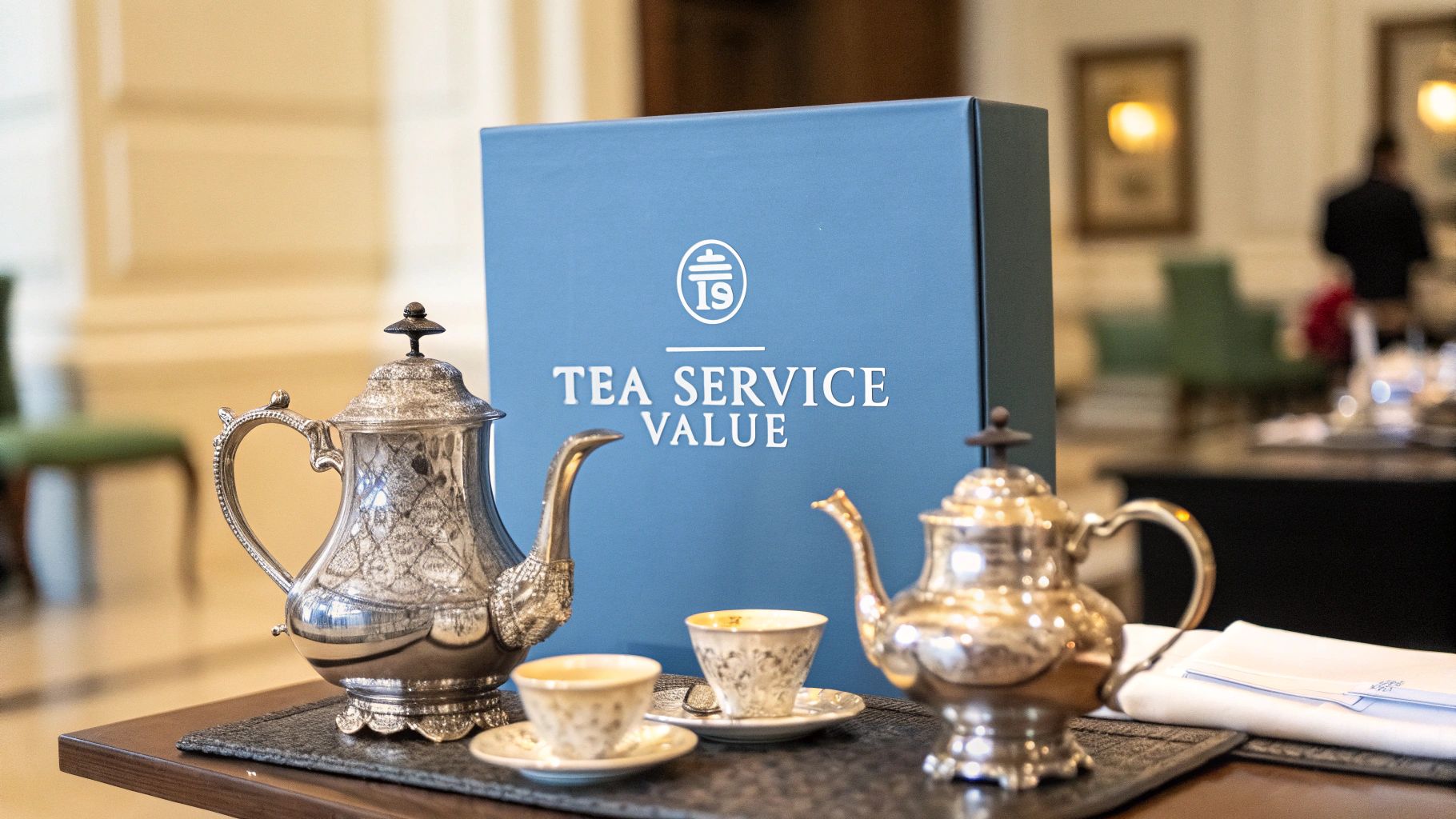The value of a silver tea service can swing wildly, from less than a hundred dollars to tens of thousands. So, what creates that massive gap? It all comes down to a few key factors: what it’s made of (sterling silver vs. silver plate), who made it, how old it is, and what kind of shape it’s in.
What Determines Your Silver Tea Service Value
Think of your tea set like a vintage car. A rare, perfectly maintained 1960s Ferrari is a collector's dream, valued for its brand, history, and pristine condition. On the other hand, a common, rusted-out sedan from the same era might just be worth its weight in scrap metal.
It's the same story with silver. The silver tea service value isn't just about the shiny metal; it's a combination of specific details that tell its story and establish its worth.
By understanding these factors, you can start to see your set through an appraiser's eyes. You'll learn that the real value lies in the craftsmanship, history, and artistry behind each piece. This guide will walk you through exactly what to look for, turning you from a curious owner into a knowledgeable evaluator.
The Core Value Factors
A few key attributes are the heavy hitters when it comes to your tea service's worth. A set's maker, age, condition, and rarity can make all the difference. For example, an antique sterling silver tea service from a legendary silversmith like Georg Jensen can easily command tens of thousands. In contrast, a beautiful but silver-plated set will have a much lower price tag because it contains very little actual silver and is less sought-after by serious collectors. You can learn more about how experts value antique silver to see these principles in action.
The single most important factor is whether your set is solid sterling silver or just silver plate. Sterling has inherent value from its high silver content, while silver plate's value is almost entirely decorative. This is the first thing any appraiser will check.
Ultimately, a set's final appraisal is a blend of tangible and intangible qualities. Here’s what you need to look at:
- Material Composition: Is it solid sterling silver (usually marked "925" or "Sterling") or silver-plated? This is the foundation of its value.
- Maker and Hallmarks: A famous name like Tiffany & Co. or Gorham instantly boosts the price. The small stamped marks (hallmarks) are the key to unlocking this information.
- Age and Style: Sets from desirable periods, like the sleek Art Deco era or the elegant Georgian period, often fetch a premium.
- Condition: Is the set complete? Are there dents, scratches, or clumsy repairs? The overall condition plays a massive role in the final price.
To give you a quick reference, here's a simple checklist to help you get a feel for where your tea service might fall on the value spectrum.
Quick Value Indicator Checklist
Use this checklist to quickly gauge the potential value of your silver tea service by comparing its key characteristics.
| Factor | High Value Indicator | Low Value Indicator |
|---|---|---|
| Material | Marked "Sterling," "925," or has official purity hallmarks. Feels heavy for its size. | Marked "EPNS," "A1," "Plate," or has no purity marks. Feels lighter. |
| Maker | A famous, collectible name like Tiffany & Co., Gorham, Paul Storr, or Georg Jensen. | An unknown, mass-market manufacturer or no maker's mark at all. |
| Age | A verifiable antique from a sought-after period (e.g., Georgian, Victorian, Art Deco). | A modern reproduction or a vintage piece from the mid-20th century or later. |
| Condition | All original pieces are present, with no dents, major scratches, or poor repairs. | Missing pieces (like a lid or sugar tongs), has significant damage, or shows signs of wear-through on the plating. |
| Craftsmanship | Intricate, hand-chased details, unique design, and solid construction. | Simple, machine-made patterns, and lightweight construction. |
This table isn't a substitute for a professional appraisal, but it’s a fantastic starting point. It helps you build a story about your set and understand what makes it special—or common.
Sterling Silver Vs. Silver Plate: The First Test
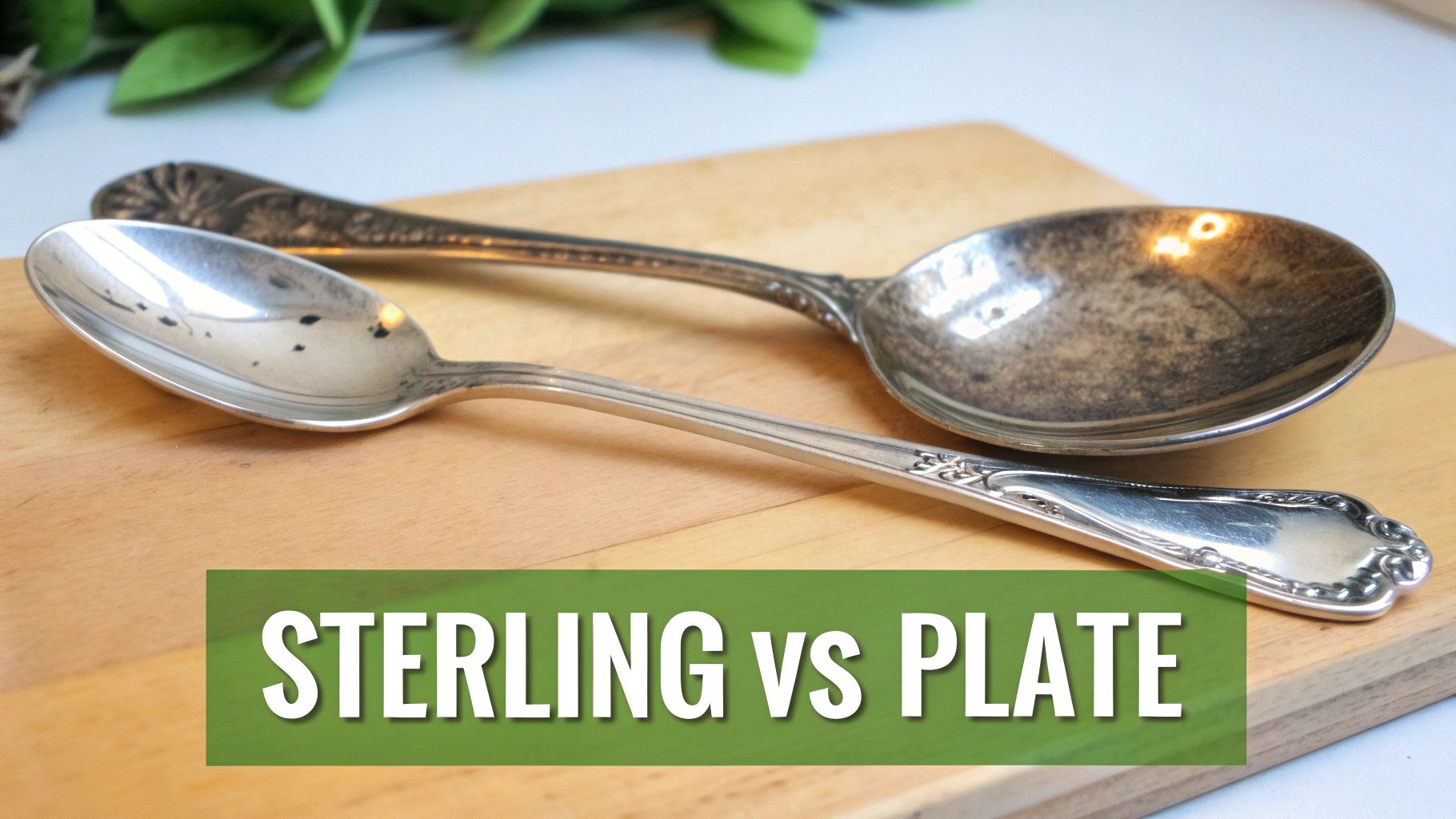
Before we can even begin to talk about the silver tea service value, there's one question that trumps all others: is it solid sterling silver, or is it silver plate? This one detail is the single biggest factor in its worth, and it separates the truly valuable heirlooms from the purely decorative pieces.
Think of it like this: a sterling silver set is a solid gold bar—its value is inherent, based on the precious metal it's made from. A silver-plated set, on the other hand, is more like a gold-foiled chocolate coin. It looks lovely on the outside, but underneath that shiny surface is a much less valuable base metal.
Getting this right is the first and most critical test in any appraisal. It sets the foundation for a realistic valuation and helps you understand what you truly have.
How to Find and Read the Marks
To figure out whether your set is sterling or plate, you'll need to do a little detective work. The clues you're looking for are tiny stamps, known as hallmarks or maker's marks, which are usually tucked away on the underside of each item. Grab a magnifying glass and find a spot with good light, then carefully check the bottom of the teapot, sugar bowl, creamer, and tray.
These little marks are the manufacturer's code, telling you exactly what you're holding. On sterling silver, these marks are a guarantee of quality. On silver plate, they describe how the piece was made.
Here’s what to look for:
Sterling Silver Marks: These confirm the piece is 92.5% pure silver.
- "Sterling" or "STERLING": The most common and direct mark you'll find, especially on pieces from American makers like Gorham or Tiffany & Co.
- "925" or ".925": This number is a universal standard, meaning 925 parts per 1,000 are pure silver.
- Lion Passant: If you see a tiny walking lion, you're looking at the classic hallmark for English sterling silver.
Silver Plate Marks: These mean a thin layer of silver was fused over a base metal (like copper, nickel, or brass).
- "EPNS": This is a dead giveaway, standing for Electro-Plated Nickel Silver.
- "A1" or "AA": These are just internal quality grades from the maker, indicating a standard thickness of the plating.
- "Quadruple Plate": Sounds impressive, but it just means a thicker layer of silver was applied. It’s still not sterling.
- Maker's Name Only: If you find a name like "Rogers Bros" or "Reed & Barton" but no "Sterling" or "925" mark, you can be almost certain it's silver plate.
It's easy to assume that any old, tarnished set must be sterling, but that's a common mistake. Many gorgeous Victorian-era sets were made with exceptionally high-quality silver plating. A mark like "EPNS" is the final word, confirming it's plated no matter how old or ornate it is.
Once you’ve found the marks, you’ve accomplished the most important step. A set confirmed to be sterling silver has a built-in floor value based on its weight, often called its "melt value." A silver-plated set, while still beautiful, has a much lower decorative value, often selling for under $200.
Decoding Hallmarks To Uncover Your Set's Story
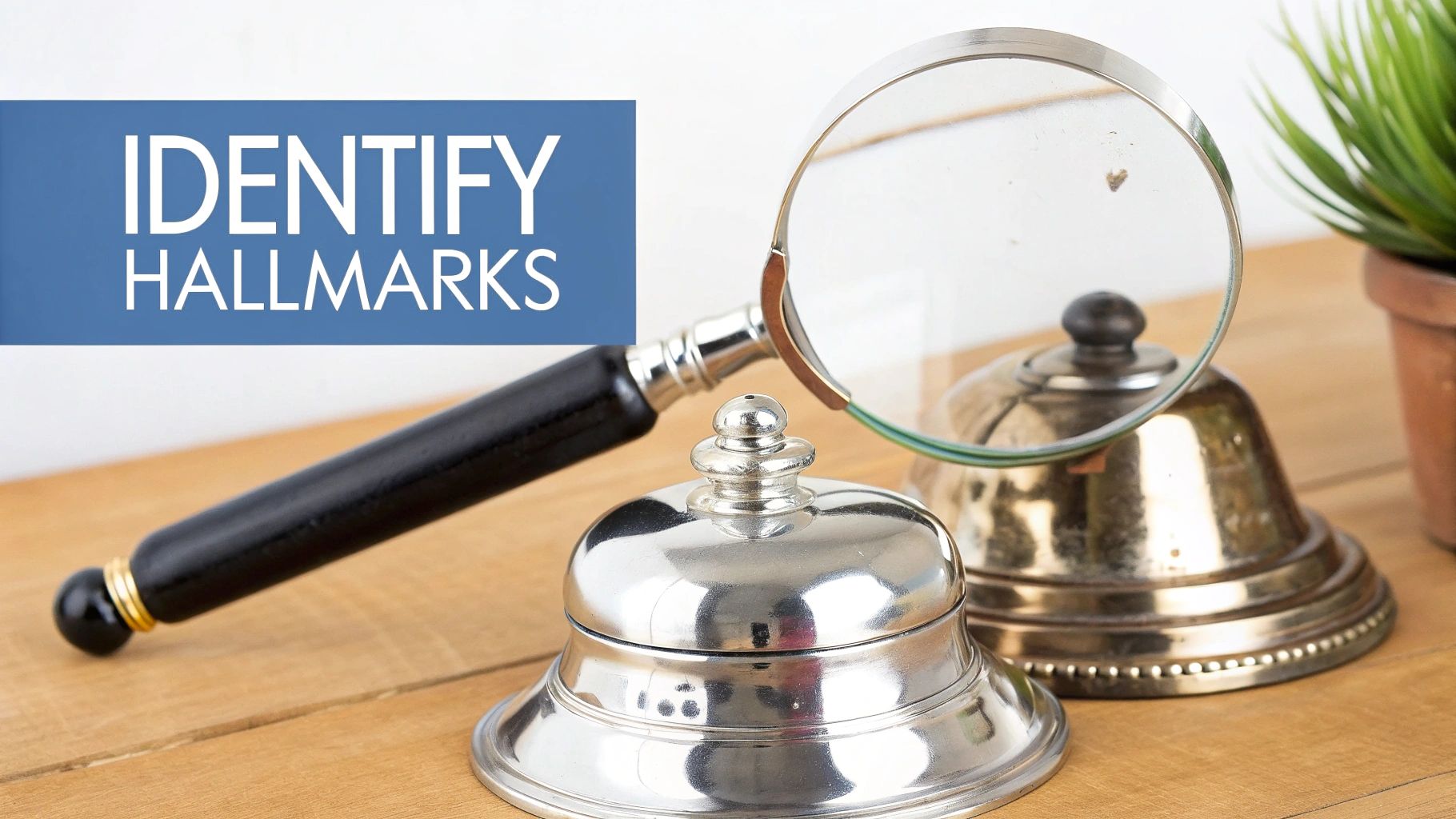
Flip over a piece from your silver tea service, and you'll likely find a series of tiny, intricate stamps. These aren't just random marks; they're a secret code, a historical passport telling you exactly who made your set, where it came from, and when it was created. Learning to read these hallmarks is like becoming a detective for your own heirlooms.
This backstory, known as provenance, is a massive driver of your silver tea service value. Think about it: a painting signed by a famous artist is worth infinitely more than a beautiful but anonymous canvas. The same logic applies here. A tea service stamped with a renowned name like Tiffany & Co. or Gorham immediately signals quality and commands a higher price.
What Hallmarks Reveal About Your Silver
Hallmarks are more than just a brand stamp; they're an official, regulated system designed to guarantee authenticity and quality. A full set of marks, particularly on antique British silver, can pinpoint a piece's history with astonishing precision. This process is very similar to a formal jewelry appraisal for insurance, where every detail is scrutinized to determine an accurate value.
So, what can these little symbols tell you?
- The Maker's Mark: This is the signature of the silversmith or company that crafted the piece.
- The Purity Mark: This mark guarantees the silver content. You might see a lion passant for British sterling or the number "925" for sterling silver.
- The Assay Office Mark: This symbol identifies the city where the silver was tested and stamped, like a leopard's head for London.
- The Date Letter: This is a letter, often in a unique font or shield, that corresponds to the exact year the piece was hallmarked.
A rich, verifiable history can boost a set's value far beyond its weight in silver. A clear link to a famous maker or a specific historical era turns a beautiful object into a collector's prize.
If you're interested in learning more, understanding https://www.curio.app/blog/what-are-hallmarks-on-silver is a great place to start your investigation.
Famous Makers That Increase Value
While countless silversmiths have produced beautiful work over the centuries, a handful of names consistently excite collectors and appraisers. Spotting one of these marks on your tea service is a very good sign.
Here are a few of the heavy hitters to look for:
- Tiffany & Co.: An American icon synonymous with luxury. Tiffany silver is celebrated for its timeless, elegant designs and impeccable quality.
- Gorham Manufacturing Company: A giant of American silver, famous for creating some of the most popular patterns ever, including their "Chantilly" design—a set of which once sold for $22,500 at auction.
- Paul Storr: An English master silversmith from the late 18th and early 19th centuries. His work is often considered the absolute pinnacle of the craft.
- Georg Jensen: A Danish silversmith whose Art Nouveau and Art Deco designs feel just as modern and stunning today as they did a century ago.
Finding a mark from one of these makers is like discovering your set has a celebrity pedigree. It’s no longer just an antique; it's a documented piece of design history, which makes it far more desirable on the market.
How Age and Style Influence Market Value
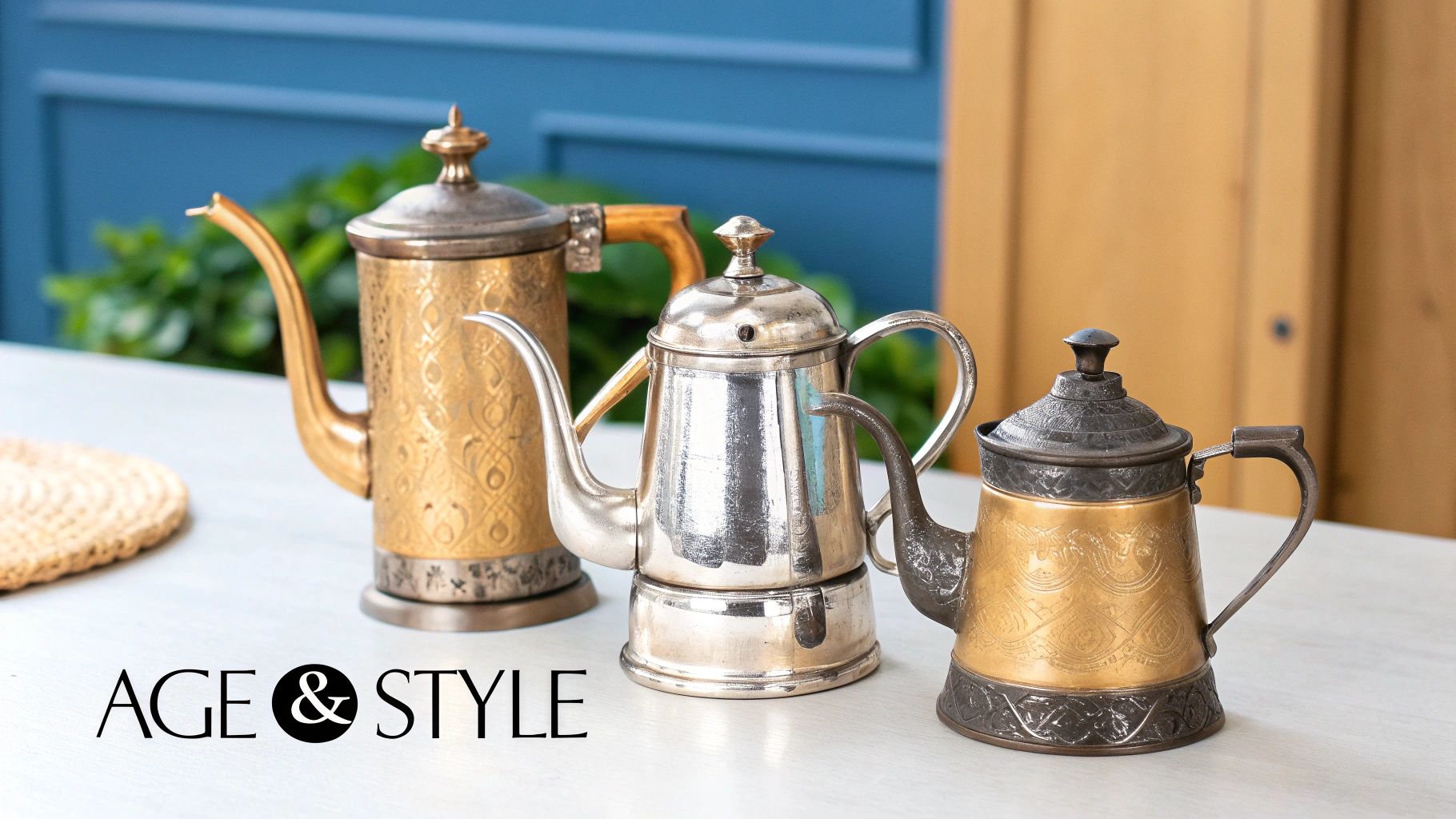
It’s easy to assume that older automatically means more valuable, but when it comes to the silver tea service value, that's a common misconception. Age is definitely a piece of the puzzle, but the design style from that era is often what really drives collector interest and, ultimately, the final price.
Think of your tea set not just as an antique, but as a time capsule of design. Its look captures the tastes and sensibilities of the period it came from, and that aesthetic will resonate differently with various buyers today. For instance, a clean, geometric Art Deco set might catch the eye of someone with a modern minimalist home, while a heavily decorated Victorian service will appeal to a collector who loves that lavish, historical look.
Figuring out where your set fits in this timeline is the first step to understanding its real-world appeal.
Identifying Your Set’s Design Era
Every era of silver making has its own unique fingerprint. Once you learn to spot these visual clues, you can place your set in its historical context, which helps you understand who the right buyer for it might be. While many iconic designs from the 18th and 19th centuries are perennial favorites, some 20th-century styles can fetch even higher prices.
Here’s a quick guide to three of the big ones you'll likely come across:
- Victorian (c. 1837–1901): Think "more is more." This era was all about showing off wealth, so the designs are often incredibly ornate. Look for elaborate floral patterns, deep engraving, and dramatic, curvy shapes. They tend to be quite heavy and intricate.
- Art Nouveau (c. 1890–1910): This style was a direct response to the stuffiness of the Victorian era. It's all about graceful, flowing lines inspired by the natural world. You’ll see elegant curves, asymmetrical forms, and motifs like whiplash lines, insects, and stylized flowers.
- Art Deco (c. 1920–1939): The complete opposite of Victorian design. Art Deco is defined by its clean, geometric shapes, bold symmetry, and streamlined forms. It has a distinctly modern feel that has never gone out of style.
It's not always about being ancient. A rare, artistically important modern set can be worth just as much, if not more, than a centuries-old piece. Case in point: a mid-century modern tea service by designer Paul Lobel sold for an incredible $377,000. That proves that exceptional design, no matter the decade, commands a premium.
How Market Trends Affect Value
The world of antiques isn’t frozen in time. It ebbs and flows with modern interior design trends and what collectors are currently searching for. Right now, the clean lines of Art Deco and Mid-Century Modern pieces are in high demand because they fit so perfectly with contemporary home aesthetics.
That doesn't mean your ornate Victorian set has lost its value. It just means its audience is different. The right buyer might be a history buff or someone who embraces a maximalist decorating style. And a classic Georgian set from the 1700s, with its understated elegance, will always have a dedicated following among serious silver connoisseurs.
At the end of the day, your tea service is more than just its age or silver content. It's a piece of art that tells the story of a specific moment in design history. Learning to recognize its style helps you appreciate its past and, more practically, understand what makes it special to today's collectors—a crucial factor in its market value.
Why Condition Is The Most Important Factor
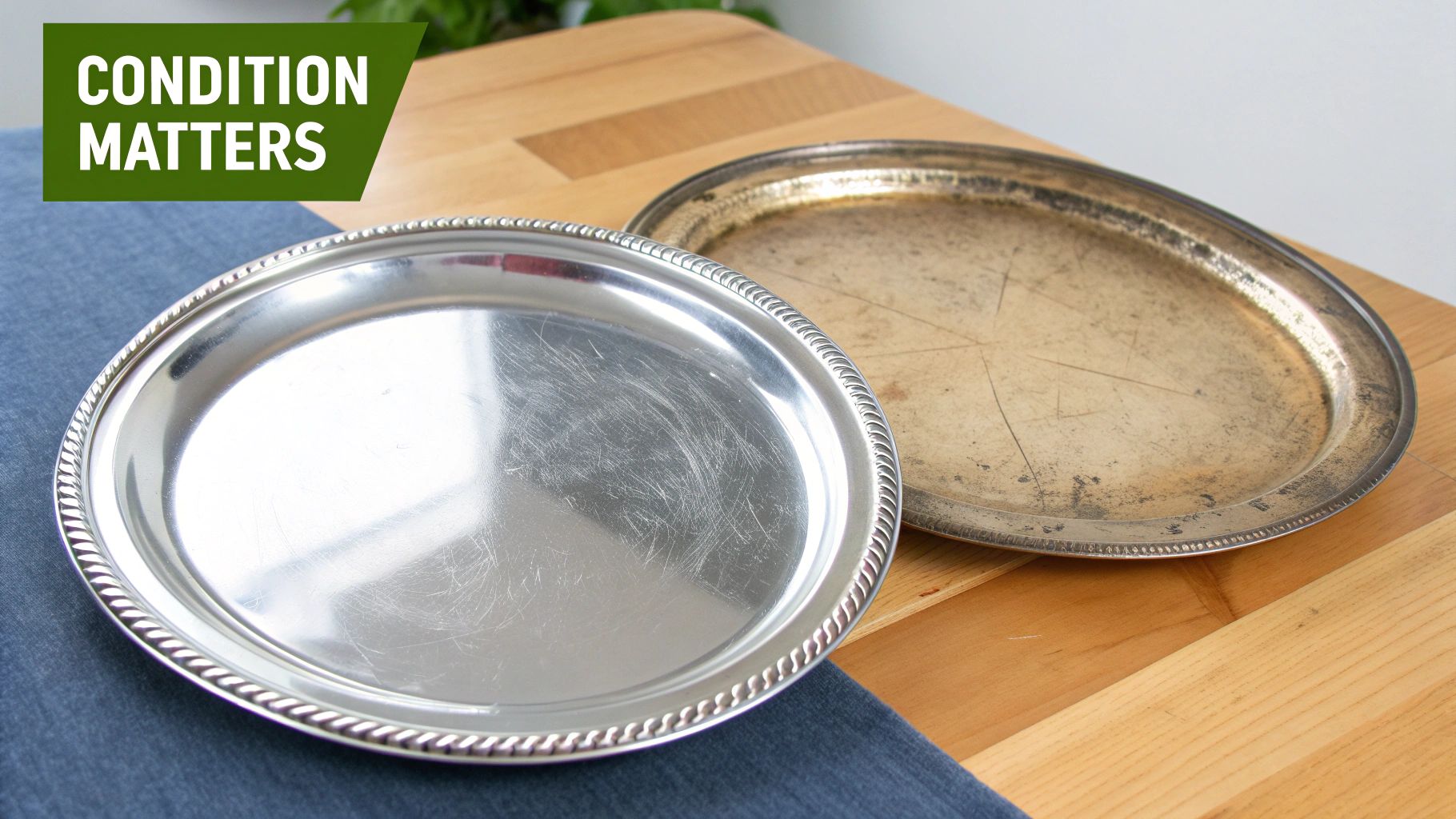
You might have a set with a prestigious maker's mark, crafted from solid sterling silver, but if it's in poor shape, none of that matters nearly as much. Think of it like a vintage car. A rare model is great, but if it's covered in rust and the engine is shot, its value is a fraction of a well-maintained example.
When it comes to silver tea service value, physical integrity is everything. Even a small dent can knock the price down, while more significant damage can be a deal-breaker for serious collectors. An appraiser will scrutinize every piece, looking for anything that compromises its beauty, function, or history. A complete, lovingly cared-for set will always bring top dollar.
Common Value-Killing Flaws
It's time for an honest look at your tea service. As you inspect each piece, keep an eye out for these common problems that can seriously hurt its value:
- Dents and Deep Scratches: A life well-lived means some minor surface wear is normal. But deep gouges or obvious dents are another story—they're distracting and often costly to repair correctly.
- Missing or Broken Pieces: A teapot is just a fancy pitcher without its original lid. A sugar bowl with a snapped-off handle is incomplete. These issues immediately lower a set's appeal and its price.
- Poor Repairs: A shoddy repair job, with globs of solder and clumsy fixes, can actually be worse than the original break. It's a red flag for any knowledgeable buyer.
The difference between a desirable, age-appropriate patina and destructive tarnish is crucial. Patina is the soft, warm glow that develops in the recessed areas of a pattern over decades. It's a sign of age that collectors value. Heavy, black tarnish or pitting, however, can permanently damage the silver's surface if left untreated.
Patina Versus Damaging Tarnish
Knowing the difference between charming patina and damaging tarnish is key. One tells a story of age and care, while the other speaks of neglect that can permanently eat into the metal.
Proper maintenance is the best way to preserve your set's condition and, therefore, its value. Learning how to properly clean silver is a great first step. If you have a silver-plated set, the cleaning process is a bit different, so our guide on https://www.curio.app/blog/how-to-clean-silver-plate-silverware has you covered. Good cleaning habits aren't just about making it look shiny; they're about preventing the kind of irreversible damage that can destroy a piece's worth.
Understanding The Modern Market For Silver
So, where does an antique silver tea service fit in our fast-paced modern world? You might be surprised. These aren't just dusty relics of a bygone era; they are part of a vibrant global market for luxury goods, appreciated as tangible assets, functional art, and of course, treasured family heirlooms.
The people buying these sets today are a diverse bunch. You have serious collectors who hunt for rare pieces, savvy investors who see silver as a stable asset, and even high-end hotels wanting to offer guests a truly exclusive experience. On top of that, many families are bringing back the tradition of formal dining and want a beautiful set to anchor new memories.
What’s driving this? It's a growing appreciation for genuine craftsmanship—something that feels more special than ever in a world of mass-produced items. Seeing your set as a part of this dynamic international market is the first step to understanding its real silver tea service value.
A Growing Global Appetite
The demand for high-end silver isn't just stable; it's growing. The global market for fine silver tea sets was recently valued at $1.2 billion and is expected to climb to $2.1 billion by 2033. This surge is fueled by a renewed love for traditional luxury in both Eastern and Western cultures. You can discover more about these market insights to see the full picture.
This strong, consistent demand provides a solid price floor for high-quality sets. If you want to dive deeper into how market forces affect pricing, our complete vintage pricing guide is a great resource.
The table below breaks down the major markets driving this global interest, highlighting where the demand is strongest and why.
Major Markets for Silver Tea Services
This table outlines key regional markets and their characteristics, helping you understand where the global demand for fine silver originates.
| Region | Market Share (Approx.) | Key Characteristics |
|---|---|---|
| Europe | ~35% | Strong tradition of silver collecting; established auction houses in London and Paris set market trends. High demand for sets with historical provenance. |
| North America | ~30% | Diverse market, from heirloom collectors to modern decorators. Strong interest in iconic American makers like Tiffany & Co. and Gorham. |
| Asia-Pacific | ~25% | Rapidly growing market, especially in China and India. Silver is seen as a status symbol and a wise investment. High demand for ornate, decorative sets. |
| Middle East | ~10% | Luxury-focused market where silver is integral to traditions of hospitality. Buyers prefer elaborate, high-carat sets from renowned makers. |
This global landscape shows that whether your set is a simple, elegant design or a highly ornate masterpiece, there's likely an enthusiastic market for it somewhere in the world.
The enduring appeal of silver tea services lies in their unique blend of utility, artistry, and history. They are one of the few antiques that can be actively used, displayed as a piece of sculpture, and hold significant intrinsic value as a precious metal.
Ultimately, the market sees a well-made silver tea service for what it is: more than just its weight in metal. It's a symbol of elegance, a tangible piece of history, and an investment in quality that continues to find a passionate audience around the globe.
Common Questions About Valuing a Silver Tea Set
Once you've done your initial research, you're often left with a few practical questions. What are the final steps? What should I absolutely not do? Getting these details right can make a huge difference in your final valuation.
Let's walk through a couple of the most common questions people have when they're ready to get their silver tea service appraised.
"Should I Polish My Set Before I Get It Appraised?"
It's a completely natural instinct—you want your silver to look shiny and new for the appraiser. But hold off on that deep clean.
A quick, gentle buff with a soft silver polishing cloth is usually okay. What you must avoid are aggressive polishes and chemical dips. Seriously, step away from the harsh chemicals.
Why? Those methods can strip away the patina, which is the soft, mellow sheen that develops over decades. Collectors and appraisers actually want to see that patina; it’s a key sign of genuine age and authenticity. Aggressive polishing can also leave behind a network of tiny scratches, permanently damaging the finish and lowering its value.
An expert would much rather see the set in its honest, as-is condition to make a proper assessment.
A personal monogram can be a double-edged sword. Most of the time, it lowers the value because it makes the set harder to sell to a general audience. But, if that engraving ties the set to a famous person or a historically important family, it could skyrocket the value. It all comes down to the story behind the name.
"Where Is the Best Place to Sell My Tea Service?"
There's no single right answer here—the best place to sell depends entirely on what you're selling. You wouldn't sell a priceless painting at a garage sale, and the same logic applies to silver.
Here's a quick breakdown:
- For High-End Antique Sterling: If you have a set from a legendary maker like Tiffany & Co. or Paul Storr, your best bet is a major auction house or a dealer who specializes in antique silver. These are the places where serious collectors are looking, and they're prepared to pay a premium for exceptional pieces.
- For Common Sterling Sets: Maybe your set is beautiful, solid sterling, but not from a world-famous silversmith. In this case, online marketplaces with dedicated antique sections or reputable local antique dealers are great options.
- For Silver-Plated Sets: Since the value of plated sets is almost entirely decorative, your goal is to find someone who loves the look. Platforms like eBay, Etsy, or even local consignment shops are perfect for connecting with buyers looking for affordable style.
Ready to uncover the story and value of your heirlooms? The Curio app puts an antique expert in your pocket. Just snap a photo to get instant identification, historical context, and a valuation estimate. Download Curio today and let your antiques tell their story.
